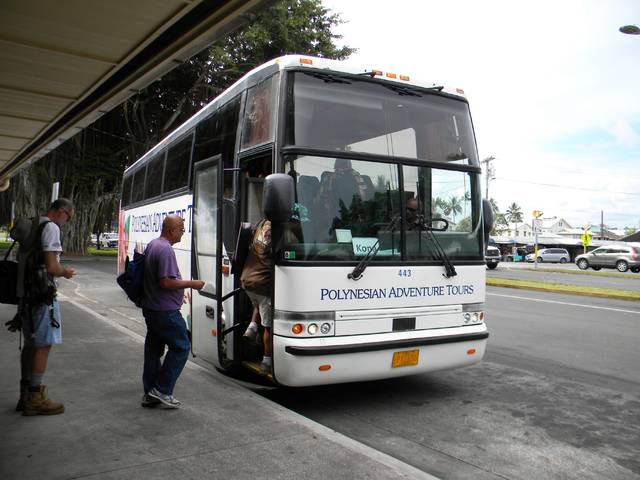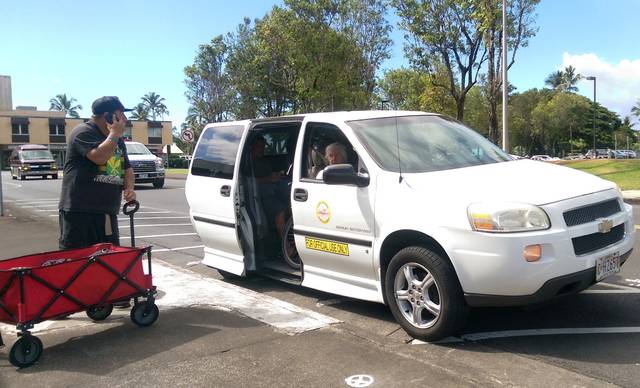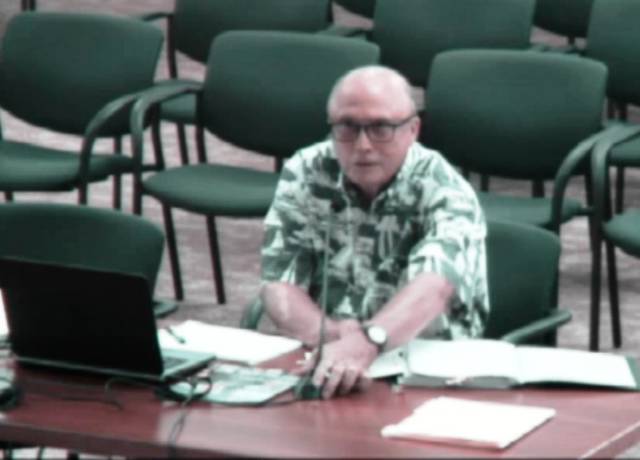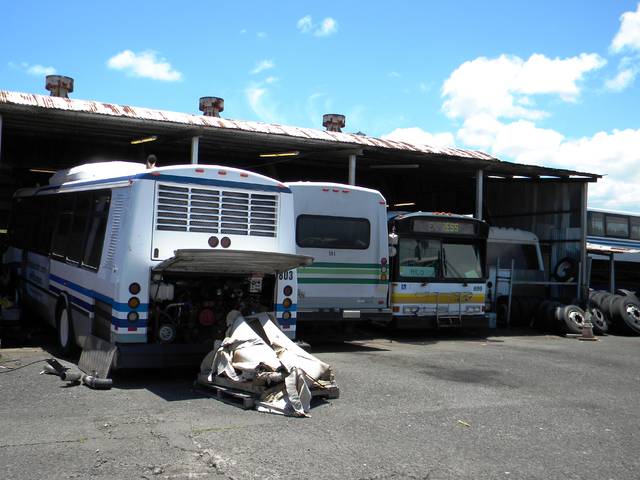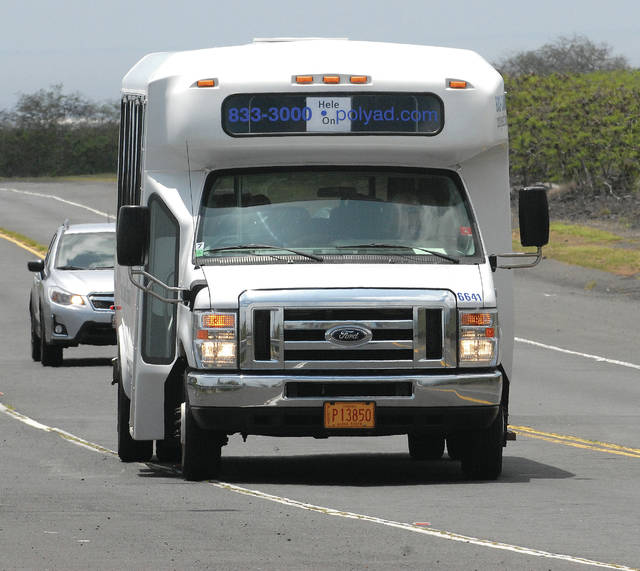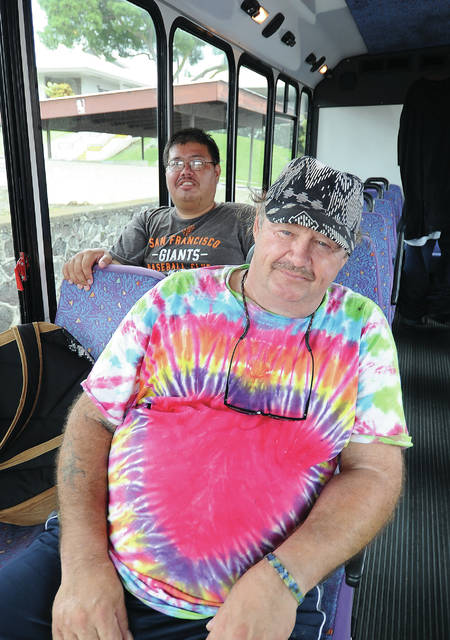HILO — When you stand at a bus stop these days, you get what you get.
Some days, it’s a regular Hele-On bus. Blue and white or green and white, big and bulky or small and rattly. Often windblown, with windows open to overcome the malfunctioning AC.
Other days, it’s a Polynesian Adventure Tours bus. Crisp and clean, air-conditioned, a soft padded ride. Or a big yellow school bus with slippery seats and all the shock absorbers of, well, a school bus.
“Oh, good, it’s the Poly Ad bus,” says Macario Baludan, a Kona boat captain who takes the bus twice weekly from Hilo.
He’s glad the county sent the comfortable bus, rather than the school bus he sometimes must ride on the bumpy, almost three-hour ride along the Hamakua Coast and across the island. Baludan is hoping to move to Kona, so he can work more hours.
On some routes, the shorter ones, a white county van rolls up. Lucky if there are only a few people in line.
“Getting off at Safeway,” the grizzled rider in the overcoat hollers.
If you’re in a substitute bus, you have to yell out your stop. There aren’t any pull ropes to signal the driver like on the regular bus.
It’s all a hodgepodge right now, as the struggling Hele-On system tries to overcome years of neglect that’s resulted in half the county’s 55-bus fleet sidelined. With 23 running buses and 23 routes, there’s no time to fix the ones that break down, let alone conduct regular maintenance to make sure they don’t.
The years of neglect in the 39-year-old bus program have reached a crisis point, leading Mayor Harry Kim to hire a consultant to turn the troubled system around. Curt Sharp, 72, a former U.S. Marine Corps. officer and Kamehameha Schools graduate from Puna, was hired on an 89-day contract in May. His $9,584-a-month contact ends July 28.
“This thing didn’t just happen yesterday,” Sharp said. “It’s kind of sad it’s gone the way it has, but that’s the past. You learn from history, you learn from mistakes.”
The County Council had a mixed reaction to Sharp’s report Monday to the Committee on Public Safety and Mass Transit. Most wanted to know how much an overhaul is going to cost.
But members of the public didn’t mince words.
Kimo Mataio, who said he once ran a private bus system, said it makes sense to have mechanics work at night to fix and maintain buses rather than have them work in the daytime when the buses are on the road.
“You work on your buses at night so they can run during the day. … That’s how you run old buses and that’s how I ran old buses,” he said. “Why is Hilo so backwards? Keep up.”
Several riders asked Hele-On to be more public service oriented. Buses don’t run on time, and people can’t depend on them to commute to work. In fact, said one testifier, people have lost their jobs because the bus didn’t get them to work on time.
Administrators are rude when they call in to get information, several said, and drivers aren’t too helpful either.
“I would please request that all drivers refrain from terming white people ‘haole,’ because it’s very derogatory,” said frequent bus rider Shelley Stevens. “It makes foreigners very uncomfortable just based on the color of their skin.”
“The way Hele-On talks to customers on the phone saying if we have a problem with the bus we can choose not to ride, or walk to town,” was a gripe presented by Matthew Gonzales.
He said some bus drivers aren’t friendly, either.
That complaint was illustrated in spades later that day, when Gonzales and a couple other passengers climbed onto an afternoon bus heading from Hilo to Keaukaha, with stops at the University of Hawaii at Hilo, Prince Kuhio Plaza and the airport.
“Somebody got to put some deodorant on,” the driver loudly complained. “It stinks,” she said, adding that it was bad enough the bus didn’t have air conditioning without having to put up with odors, too.
The county has started renting buses to fill in the gaps. It’s not cheap. The combination of buses, at $1,500 to $2,000 each, is costing taxpayers $10,000 a day — money that’s sorely needed for parts and repairs of the county’s own buses.
The City and County of Honolulu recently donated seven used buses to the Big Island. They’ve checked out as road-ready, said Sharp, but they’re awaiting state certification and licensing before they’re added to the fleet.
Sharp’s currently working out of the mayor’s office, but he’s applied for the permanent position of Mass Transit administrator. Seven applicants turned in their resumes for that civil service position, slated at $67,728 annually, as of Tuesday’s deadline, according to a county Human Resources official.
Once the applicants are screened, the information will be sent to Kim, who makes the final decision.
Sharp is recommending a number of steps to bring the bus system up to snuff.
Obviously, he said, the county needs to get more buses on the road, to stop the bleeding from renting daily buses.
The new $12 million baseyard needs to be completed, to improve staff morale and help them work more efficiently than they can at the current site, which Sharp said has “deplorable working conditions.” The new facility, originally scheduled for completion last year, should be finished in the next several months.
Routes and schedules, now being worked on by a consultant, need to be revamped. Currently, big, heavy gas-guzzling buses are running routes with just a few people on them, while other buses are standing-room-only.
The County Council in 2015 approved $500,000 for the consultant to create a mass transit master plan, setting routes and schedules. The consultant, SSFM, began on-board rider surveys earlier this year and plans community meetings for more public input.
“It’s really inconvenient and not practical to take the bus,” said South Kona/Ka‘u Councilwoman Maile David. “We need to get our people from the outskirts of our county to the urban centers where they work.”
Sharp would like to see another mechanic hired to bring the total to six, as well as a shop foreman, an inventory manager and a quality assurance employee. Then, there’s the need to stock common spare parts and buy two or three new buses, he said.
Sharp knows whoever takes on the new position will have their work cut out for them, managing the 13-employee agency while pushing for improvements.
“There are a lot of complaints out there, a lot of negativity which we’re trying, which I’m trying to overcome,” Sharp told the council.
Council members say the administrative issues, such as customer satisfaction and the actual operation of the bus, are issues outside their control. What they’re focused on, several said, is the bottom line.
The council budgeted $14 million this year for transit operations and improvements, up slightly from last year. Half of the money comes from the general fund, which comes primarily from property taxes, and half comes from the highway fund, collected from gas taxes and franchise fees to utilities.
“Every single member of this council wants to know how much is this going to cost. These things are rather alarming to an agency that we are supplementing to the tune of $14 million,” said Hilo Councilwoman Sue Lee Loy. “Every single member of this council is going to be held accountable to their constituents about the budget.”
Federal grants account for just $1.2 million of the budget, and with fares accounting for $960,000, the county pays an average $11.77 per rider. Riders pay $1-$2 fares, depending on their age and whether they have disabilities.
“Subsidizing something that has a lot of holes in it is a concern,” said Kohala Councilman Tim Richards. “I was one of the guys who don’t want to throw a lot of resources at something without a very conscientious and thoughtful program presented to us. … Throwing money at something makes us feel better, but if it doesn’t fix the problem, we’re wasting resources of the county.”
In response to Richards’ questions, Sharp said he is considering the possibility of raising fares and soliciting advertising on the buses.
Still, said Puna Councilwoman Jen Ruggles, who requested Sharp make the presentation to the committee she chairs, public transportation is essential as a safety net for working people who might not be able to afford cars, as well as others who don’t drive.
“This is a really vitally important service that we provide,” Ruggles said. “We have a growing aging population. … They’re going to be more reliant on our public transportation system.”
Hilo Councilman Aaron Chung agreed.
“The fact is this mass transit system is vitally important to improve the quality of life of our residents,” he said, “and it’s becoming more important every year.”
It’s not all gloom and doom, though. Sometimes the bus is full of happy college students, chattering in a variety of languages about their experiences at school.
Drivers act as tour guides, pointing out sea turtles and points of interest and helping newcomers find their way.
On cruise ship days in Hilo, “Uncle Mattie” Kamelamela is often in the first seat, playing his ukulele as he leads a sing-along for the tourists.
It’s all part of the experience when you ride the bus in paradise. Warts and all.







